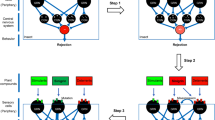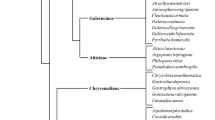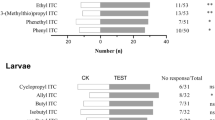Abstract
Larvae of the cabbage white Pieris rapae are specialists on plants belonging to the family Brassicaceae (Cruciferae). Adult females have been shown to use the glucosinolate gluconasturtiin (phenylethylglucosinolate) as a recognition cue for cruciferous plants, so they can identify an appropriate host for oviposition (Huang and Renwick in J Chem Ecol 20:1025–1037, 1994). Here, we report our results from a study of the role of this glucosinolate in feeding preferences of P. rapae larvae. The larvae were allowed to choose between leaf disks from the non-host cowpea Vigna sinensis (Fabaceae) that were treated with pure gluconasturtiin in solvent, or solvent alone. Our results showed that gluconasturtiin is a feeding stimulant for P. rapae larvae. A series of chemosensory ablations revealed that this response is mediated by one set of taste sensilla, the sensilla styloconica. Electrophysiological tip recordings revealed two neurons in the lateral sensillum styloconicum that are sensitive to gluconasturtiin. These neurons show significantly higher firing frequencies with 4 mM gluconasturtiin added to the recording pipette than for recording solution alone. We propose that the sensitivity to gluconasturtiin shown by these two taste neurons is an important contributor to the animals’ behavioral preference for this compound.






Similar content being viewed by others
Abbreviations
- ANOVA :
-
Analysis of variance
- KCl :
-
Potassium chloride
- L1 :
-
lateral-1
- L2 :
-
lateral-2
- L3 :
-
lateral-3
- L4 :
-
lateral-4
- LSD :
-
Least significant difference
- M1 :
-
medial-1
- M2 :
-
medial-2
- M3 :
-
medial-3
- M4 :
-
medial-4
References
Abisgold JD, Simpson SJ (1988) The effect of dietary protein levels and haemolymph composition on the sensitivity of maxillary palp chemoreceptors of locusts. J Exp Biol 135:215–229
Barton-Browne L (1975) Regulatory mechanisms in insect feeding. Adv Insect Physiol 11:1–116
Bernays EA (1985) Regulation of feeding behaviour. In: Kerkut GA, Gilbert L (eds) Comprehensive insect physiology, biochemistry and pharmacology. Pergamon Press, Oxford, pp 1–32
Bernays EA, Simpson SJ (1982) Control of food intake. Adv Insect Physiol 16:59–118
del Campo ML, Miles CI (2003) Chemosensory tuning to a host recognition cue in the facultative specialist larvae of the moth Manduca sexta. J Exp Biol 206:3979–3990
del Campo ML, Miles CI, Schroeder FC, Müller C, Booker R, Renwick JAA (2001) Host recognition by the tobacco hornworm is mediated by a host plant compound. Nature 411:186–189
del Campo ML, Via S, Caillaud MC (2003) Recognition of host-specific chemical stimulants in two sympatric host races of the pea aphid Acyrthosiphon pisum. Ecol Entomol 28:405–412
Dethier VG, Crnjar RM (1982) Candidate codes in the gustatory system of caterpillars. J Gen Physiol 79:549–569
Devitt BD, Smith JJB (1985) Action of mouthparts during feeding in the dark-sided cutworm, Euxoa messoria (Lepidoptera: Noctuidae). Can Entomol 117:343–349
Du Y-J, van Loon JJA, Renwick JAA (1995) Contact chemoreception of oviposition-stimulating glucosinolates and an oviposition-deterrent cardenolide in two subspecies of Pieris napi. Physiol Entomol 20:164–174
Fahey JW, Zalcmann AT, Talalay P (2001) The chemical diversity and distribution of glusosinolates and isothiocyanates among plants. Phytochemistry 56:5–51
Feeny P (1977) Defensive ecology of the Cruciferae. Ann Mo Bot Gard 64:221–234
Glendinning JI, Valcic S, Timmerman BN (1998) Maxillary palps can mediate taste rejection of plant allelochemicals by caterpillars. J Comp Physiol A 183:35–43
Gothilf SE, Hanson FE (1994) Technique for electrophysiologically recording from sensory organs of intact caterpillars. Entomol Exp Appl 72:305–310
Huang XP, Renwick JAA (1994) Relative activities of glucosinolates as oviposition stimulants for Pieris rapae and Pieris napi oleracea. J Chem Ecol 20:1025–1037
van Loon JJA (1990) Chemoreception of phenolic acids and flavenoids in larvae of two species of Pieris. J Comp Physiol A 166:889–899
van Loon JJA, van Eeuwijuk FA (1989) Chemoreception of amino acids in larvae of two species of Pieris. Physiol Entomol 14:459–469
van Loon JJA, Blaakmeer A, Griepink FC, van Beek TA, Schoonhoven LM, de Groot A (1992) Leaf surface compound from Brassica oleracea induces oviposition by Pieris brassicae. Chemoecology 3:39–44
van Loon JJA , Schoonhoven LM (1999) Specialist deterrent chemoreceptors enable Pieris caterpillars to discriminate between chemically different deterrents. Entomol Exp Appl 91:29–35
Ma WC (1972) Dynamics of feeding responses in Pieris brassicae Linn. as a function of chemosensory input: a behavioral, ultrastructural and electrophysiological study. Meded Landbouwhogesch Wageningen 72–11:1–162
Menken SBJ, Roessingh P (1998) Evolution of insect-plant associations. Sensory perception and receptor modifications direct food specialisation and host shifts in phytophagous insects. In: Howard DA, Berlocher S (eds) Endless forms. Oxford University Press, Oxford, pp 145–156
Miles CI, Booker R (2000) Octopamine mimics the effects of parasitism on the foregut of the tobacco hornworm Manduca sexta. J Exp Biol 203:1689–1700
Renwick JAA (1996) Diversity and dynamics of crucifer defenses against adults and larvae of cabbage butterflies. In: Romeo JT, Saunders JA, Barbosa P (eds) Recent advances in phytochemistry 30. Plenum Press, New York, pp 57–79
Renwick JAA (2002) The chemical world of crucivores: lures, treats and traps. Entomol Exp Appl 104:35–42
Renwick JAA, Huang XP (1995) Rejection of host plant by larvae of cabbage butterfly: diet-dependent sensitivity to an anti-feedant. J Chem Ecol 21:465–475
Renwick JAA, Lopez K (1999) Experience-based food consumption by larvae of Pieris rapae: addiction to glucosinolates? Entomol Exp Appl 91:51–58
Renwick JAA, Radke CD, Sachdev-Gupta K, Städler E (1992) Leaf surface chemicals stimulating oviposition by the Pieris rapae (Lepidoptera: Pieridae) on cabbage. Chemoecology 3:33–38
Schoonhoven LM (1967) Chemoreception of mustard oil glucosides in larvae of Pieris brassicae. Proc Kon Ned Akad Wet Ser C 70:556–568
Schoonhoven LM (1969a) Amino-acid receptor in larvae of Pieris brassicae. Nature 221:1268
Schoonhoven LM (1969b) Gustation and foodplant selection in some lepidopterous larvae. Entomol Exp Appl 12:555–564
Schoonhoven LM (1972) Secondary plant substances and insects. Recent Adv Phytochem 5:197–224
Schoonhoven LM, Dethier VG (1966) Sensory aspects of host-plant discrimination by lepidopterous larvae. Arch Neerl Zool 16:497–530
Schoonhoven LM, van Loon JJA (2002) An inventory of taste in caterpillars: each species its own key. Acta Zool Acad Sci Hung 48(Suppl 1):215–263
Scott K, Brady R, Cravchik A, Morozov P, Rzhetsky A, Zuker C, Axel R (2001) A chemosensory gene family encoding candidate gustatory and olfactory receptors in Drosophila. Cell 104:661–673
Sherman P, Reeve HK, Pfennig DW (1997) Recognition systems. In: Krebs JR, Davies NB (eds) Behavioral ecology; an evolutionary approach. Blackwell Science, Oxford, pp 69–96
Städler E, Renwick JAA, Radke C, Sachdev-Gupta K (1995) Tarsal contact chemoreceptor response to glucosinolates and cardenolides mediating oviposition in Pieris rapae. Physiol Entomol 20:175–187
Verschaffelt E (1910) The cause determining the selection of food in some herbivorous insects. Proc R Acad Amst 13:536–542
Acknowledgements
This work was supported by NSF #IBN-0081051 to J.A.A.R. and C.I.M. and partly supported by NSF #DBI-0208238 to M.L.Oliva (a.k.a. del Campo). We are grateful to Dr. John Pickett for providing a sample of synthetic gluconasturtiin for these studies. We thank Nadia Ansari, Marina Gusel, Jeanette Ryan and Beth Silverstein for their assistance with the behavioral bioassays. Experiments comply with regulations for animal experimentation in the USA.
Author information
Authors and Affiliations
Corresponding author
Rights and permissions
About this article
Cite this article
Miles, C.I., Campo, M.L.d. & Renwick, J.A.A. Behavioral and chemosensory responses to a host recognition cue by larvae of Pieris rapae. J Comp Physiol A 191, 147–155 (2005). https://doi.org/10.1007/s00359-004-0580-x
Received:
Revised:
Accepted:
Published:
Issue Date:
DOI: https://doi.org/10.1007/s00359-004-0580-x




